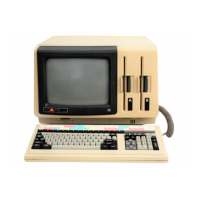GSX-86: Graphics
for
the
APe
The
GDOS
contains the basic host-independent
and
device-independent graphics
functions
that
can
be called
by
an
application
program.
GDOS
provides a
standard
interface
to
graphics
that
is
constant
regardless
of
specific devices
or
host
hardware,
just
as the
BDOS
standardizes disk interfaces.
Application
programs
access the
GDOS
in much the same way
that
they access the BDOS.
The
GDOS
performs
coordinate scaling so
that
a
program
can specify
points
in a
normalized coordinate space. It uses device-specific
information
to translate the
normalized coordinates into the corresponding values
for
each graphics device.
Multiple graphics devices
can
be
supported
under
GSX-86 within a single applica-
tion. By referring
to
devices with a workstation identification number,
an
application
program
can send graphics
information
to
anyone
of
several devices.
The
Graphics
Input/Output
System
(GIOS)
is
similar
to
the BIOS.
It
contains
the
device-specific code required
to
interface specific graphics devices
to
the
GDOS.
The
GIOS
consists
of
a set
of
device drivers
that
communicate
directly with the
graphics devices. GSX-86 requires a unique device driver
for
each different graphics
device
on
a system. The term
GIOS
refers
to
the functional layer in GSX-86
that
holds the collection
of
available device drivers. The
particular
driver
that
is
loaded
into
memory
when required
by
an
application
is
called a
GIOS
file. Although a
single
program
can
use several graphics devices,
GDOS
loads only one
GIOS
file
at
a time.
The
GIOS
performs
the graphics primitives
of
GSX-86, consistent with the inherent
capabilities
of
a graphics device. In some cases, a device driver emulates
standard
GDOS
capabilities which are
not
provided
by
the graphics device
hardware.
For
example, some devices require
that
dashed
lines be simulated
by
a series
of
short
vectors generated in the device driver.
Memory Management
The
default
device driver
and
GDOS
are
loaded
directly above CPM-86
after
the
GRAPHICS
command
has been executed. The application
program
is
loaded
in the
normal
manner,
starting
at
the
top
of
the user area.
9-7

